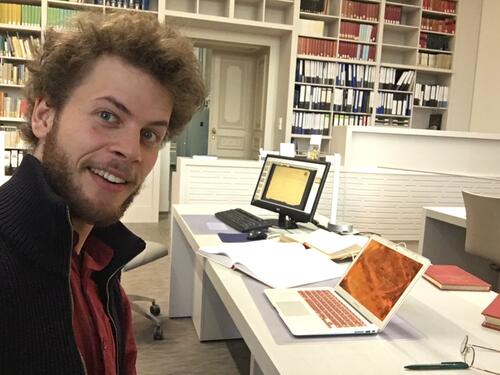
Miklós Veszprémi is a PhD candidate in music theory. His dissertation is on “double function form” works, in which musical form unfolds on multiple, mutually exclusive hierarchical levels simultaneously. It asks how mid nineteenth-century listeners perceived such forms, and focuses on the reception and international dissemination of Franz Liszt’s Second Piano Concerto.
Using an ESC grant, I visited the Liszt Archive in Weimar at the end of February 2019. The journey was successful. As anticipated, I was able to examine Manuscript GSA 60:5H3, which contained an incomplete full score by Liszt’s student Belloni. Previously, I had transcribed the handwritten manuscripts GSA 60:H5c and H5d, which were, respectively, the full score minus the piano and the piano solo score. Upon returning home from my first trip in January, I merged the two together myself, encountering a number of questions along the way. The manuscript I examined provided answers to many of these questions, but also raised a number of new ones, the resolution of which I found to be a very interesting and fruitful endeavor. H3 follows closely behind H5d, but disregards the markings in colors other than black ink. It disregards numerous H5c changes. I was able to deduce the following production sequence:
- H5d without the extra markings: Liszt’s original sketch.
- Piano solo part copied out onto the pages of H3 by Belloni.
- Belloni extrapolated the orchestra from it.
- Parallel to and/or independently of 2 and 3, Liszt adds a number of changes to H5c, presumably in preparation for the full score.
- Again parallel to and/or independently of 2 and 3, Liszt writes out a full score without piano, H5c.
- Some time later, Liszt makes a number of change suggestions in H3 that serve to make the piano solo part a little less unwieldy. The fact that the orchestral parts of H3 and H5c are so similar is striking indicates that H3 was completed under Liszt’s guidance, but without Liszt’s version of it (H5c), since otherwise more formal similarity between the two would have been observed.
But what does this indicate about Liszt’s intentions for the concerto around 1840? Having established a hypothetical order for the production of the manuscripts, I am currently investigating Liszt’s contact with Belloni in the early 1840s in an effort to date these manuscripts and propose an explanation for the events that may shed light on why the concerto virtually vanished until 1849.

